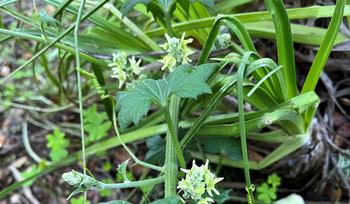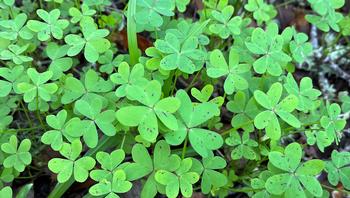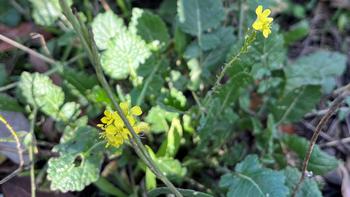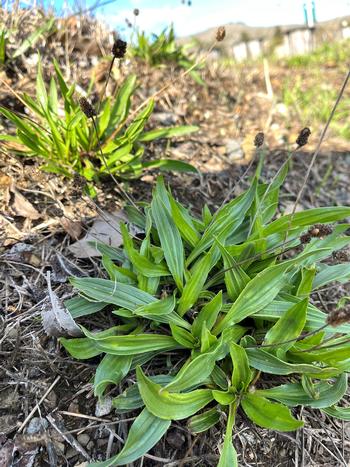In praise of weeds
-
James Campbell
-
I admit it. I am terrible at weeding. With the winter rains, my yard turns into a lush garden of plants I never planted. Ralph Waldo Emerson described weeds as “a plant whose virtues have not yet been discovered.” To most gardeners, a weed is a plant growing in the wrong place. But if I put my sustainable gardening cap on, there is much to appreciate about weeds. For example, weeds can tell us a lot about our soil conditions. Some weeds are edible, and some can be added to our compost piles if done carefully. A new study highlights the importance of weed flowers to our pollinators. It turns out weeds do have virtues and can be downright beneficial.
 Despite the name, wild cucumber is not edible. Be certain to properly identify any weeds before you eat them. Photo: James Campbell
Despite the name, wild cucumber is not edible. Be certain to properly identify any weeds before you eat them. Photo: James CampbellYou can learn to read your weeds. If you can identify the patch of weeds, they will tell you about the condition of the soil they are growing in. Look at the roots of the weeds to see if they have a deep taproot, like dandelions and plantain. This generally indicates that your soil is compacted in that area, preventing plants with finer roots from taking hold. These taproots are beneficial and break up the soil. As the roots decompose, they create pathways for water and nutrients. Like clover, weeds with a net-like root system signal that the soil is loose and possibly erosive.
 Oxalis prefers soil that is low in calcium but high in magnesium; learn to read your weeds. Photo: James Campbell
Oxalis prefers soil that is low in calcium but high in magnesium; learn to read your weeds. Photo: James CampbellThe type of weed patches you find in your garden can also tell you if your soil is alkaline or acidic. Mullein and stinging nettle prefer acidic soils, while goosefoot and chickweed grow in alkaline soils.
Pigweed, lambsquarters, common groundsel, and purslane are all found in rich soil high in nitrogen. Oxalis prefers soil that is low in calcium but high in magnesium. Mustard likes soil that is high in phosphorus. Weeds can sometimes be a symptom of soil that needs help. Use the clues provided by the weeds to help your soil recover.
Many weeds we find in our gardens are edible. Chickweed, lambsquarters, purslane, and dandelion all make great fresh and free additions to salads. Nettles can be cooked and used as a substitute for spinach in any recipe. Make certain you have correctly identified anything you are going to eat. The University of California provides great online tutorials and information. http://ipm.ucanr.edu/PMG/weeds_intro.html. Wild mustard has little yellow flowers is one of the richest sources of pollen bees see all year. Photo: James Campbell
Wild mustard has little yellow flowers is one of the richest sources of pollen bees see all year. Photo: James CampbellIf eating weeds is not your thing, think about weeds as a way to add to the compost pile you use to feed and nourish your garden soil. Annual weeds can be chopped up before they flower, left in place, or added to your compost bin. Perennial weeds are a little trickier. Cut them down before they flower, and let them dry out completely before adding them to your compost. You want to be careful that your compost does not become a weed incubator. Always consider fire-safe landscaping practices in your weed management strategy.
A new study out of the University of Sussex in the UK illuminates the importance of weeds to pollinators. The study compared the biodiversity value of weeds with plants that support pollinator health. The study observed that insects visited the flowers of weeds, such as ragwort and thistles, at a much higher rate than some of the recommended pollinator-supportive wildflowers. One reason for the popularity of these weed flowers was the open structure of the flowers which allows access to several different pollinator species. Another finding was that the weeds produced, on average, more nectar than many pollinator-supportive flowers. The researchers acknowledged that weeds could affect agricultural and pasture lands but emphasized that the value of pollinators to global biodiversity, ecosystem resilience, and agricultural output needs consideration too. Buckhorn plantain has a taproot that indicates the soil where it is growing may be compacted. Photo: James Campbell
Buckhorn plantain has a taproot that indicates the soil where it is growing may be compacted. Photo: James CampbellThis winter, I am looking at my weeds a little differently than I have in the past, no longer the foe but a partner in my sustainable gardening practice.




